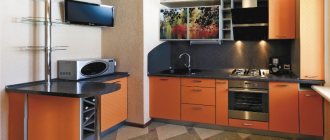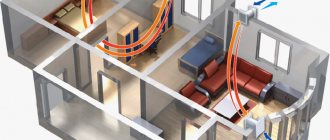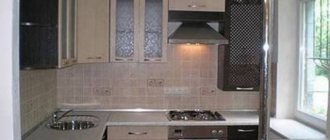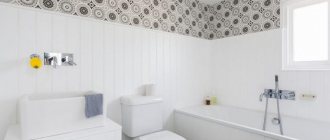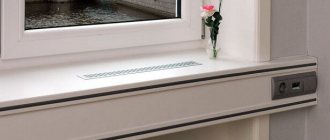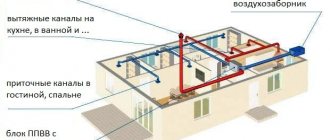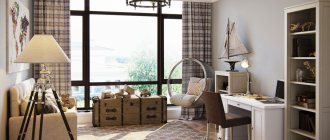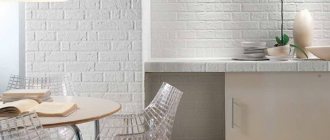.
Modern apartments are equipped with metal-plastic windows instead of wooden ones, which worsens the air exchange in the house. Natural ventilation can be established using ventilation or installing supply and exhaust mechanisms.
Installing plastic windows significantly worsens the quality of air exchange. However, you can find a way out
What is the purpose of the ventilation system in an apartment with installed plastic windows?
Plastic windows not only disrupt heat exchange in the apartment, but also contribute to the accumulation of carbon dioxide and moisture. They are made using completely sealed technology, so heat does not escape from the apartment, but moisture does not escape either. Therefore, forced ventilation in an apartment with plastic windows is simply a salvation for all family members and the home.
Ventilation for an apartment is divided into several types:
- Natural. This is done by ventilating plastic windows in various modes or using ventilation shafts installed in the functional areas of the apartment.
- Forced. This is achieved by installing various devices on plastic windows or installing systems in the apartment.
It is important to install ventilation correctly and not make a mistake with its choice, having studied specialized literature for this.
Window fittings
Metal parts will ensure the window opens in different planes
When assembling a window, metal parts are installed in a groove on the profile, which provide various opening positions and clamping of the sash in the closed position. A micro-ventilation mechanism can be included in this system. Ideally, it is installed immediately at the time of assembly at the factory.
But if the window was installed a long time ago, it is quite possible to install the mechanism on site. To do this, you should contact specialists. Any company engaged in the repair of metal-plastic structures provides this service.
The mechanism fixes the gap between the sash and the frame, sufficient for air flow (no more than 3 mm). It usually opens by turning the handle 45 degrees. There are multi-stage locking mechanisms (handle rotation by 15, 45 and 60 degrees).
Natural ventilation
Proper air exchange in the apartment allows you to remove excess moisture and exhaust air, and along with them, fungal and mold spores. Natural ventilation copes with this task only with through ventilation, but it cannot be used during the cold season.
But not all of us care about ventilation and check it regularly, although ventilation shafts in apartments often work poorly because they are clogged with construction or street debris. Not everyone knows how to check the ventilation in an apartment on their own.
You can check the effectiveness of ventilation in the ducts using a piece of paper. If the sheet is attracted, then the ventilation works well. If it does not move, then such ventilation is of no use; you will have to call a technician to check the functionality and clean the channels.
Using a sheet of paper you can check the effectiveness of ventilation
In order for natural ventilation in an apartment with plastic windows to normalize the microclimate in the apartment, it must be converted into forced ventilation. This can be done by installing specialized air blowers or split systems with climate control function.
Prices
A budget Breezer, designed for 32 m2 , costs 21,000 rubles . Model with a capacity of up to 140 m3/hour – 43,000 rub.
A supply wall valve will cost much less - the cost ranges from 1000 rubles. for a simple device, up to 8500 rub. for a model with a turbine and a high-quality filtration system.
The cost of a valve mounted on a window without milling is from 350 rubles. Overhead modifications that require complex installation - up to 4,500 rubles.
Forced ventilation
In new buildings, a forced ventilation system is installed during the construction stage. And where ventilation of this type is not provided for by the project, it is installed during the renovation process.
The principle of operation of a forced ventilation device is to organize draft through special channels by fans.
The supply unit is installed indoors, through a specialized valve, which is installed in a hole in the wall. From the outside, the hole is closed with a grille, which protects it from debris and various foreign bodies.
Supply ventilation in the form of a system is installed in one room and then distributed throughout all rooms using ventilation ducts or installed in each room of the apartment separately.
Forced ventilation is installed on domestic natural ventilation ducts. It consists of fans that increase air draft. They are often installed in the kitchen or bathroom, and sometimes in other rooms where it is necessary to establish air exchange.
Air supply units can be equipped with additional devices: a heater or a recuperator, which will allow you to heat cold street air in winter. And the recuperator will also save additional money on heating the room.
Before installing a forced ventilation system, you need to know the following parameters:
- the size of the room or the entire apartment where forced ventilation will be installed;
- air humidity in the room itself and the required value for comfortable living in this apartment;
- the environmental situation in the area, the level of gas pollution and vehicle traffic;
- the number of people living in the apartment permanently;
- the presence of chronic diseases of the respiratory system and immune system in residents.
This data will help you choose the appropriate device or ventilation method to restore air exchange in the room.
Condensation on the surface of the window glass
From time to time, despite all the tricks aimed at reducing the level of humidity in the room, condensation still appears on the window glass. Many people use various folk remedies to combat it, wipe the windows with dry napkins and rags, and additionally ventilate the room afterward.
Only ventilation grilles for window sills will help you cope with the emerging situation once and for all. Only they will keep the window profile dry, thereby extending its service life for a long time.
Types of devices
A grill installed in the window sill more effectively distributes the flow of warm air near the window, preventing the accumulation of liquid on the glass.
There are many varieties of these devices:
- external, internal and transfer;
- unregulated, adjustable and inertial.
In addition, depending on the type of materials used, gratings are divided into:
- polymer - one of the most common materials, which over time can turn yellow and warp from exposure to high temperatures;
- aluminum - have a good light weight and appearance, the disadvantage is a high price;
- made of wood - goes well with any type of room design, but requires care and special attention;
- metal - have enormous weight, price and attractive appearance.
Installing gratings on a window sill
To independently install devices that help eliminate condensation from the surface of window glass and frame, you need to stock up on the following tools:
- drill;
- marker;
- jigsaw;
- glue for joining polymers;
- weight to secure the grille during installation.
The sequence of actions for installing the grille on the window sill is as follows:
- A pre-purchased device is applied to the window sill, which is outlined along the contour with a pencil or marker.
- Holes are made in the corners of the resulting figure using a drill. Their diameter should be slightly larger than the width of the jigsaw blade.
- After this, a part of the window sill is cut out along the drawn lines. In the future, the place of the removed part will be taken by a decorative grille, providing free access to heated air.
- Then gluing is done. Excess adhesive must be immediately removed with cotton or linen cloth. Once the glue has hardened, this will be problematic.
- Before complete polymerization, a weight must be placed on the attached ventilation grille.
Combining ventilation and windows
Anyone who cares about their own health is interested in the possibility of maintaining proper air exchange in an apartment with plastic windows.
Maintaining proper air exchange in an apartment with plastic windows is a necessity for those who care about their health
There are many options for upgrading natural duct ventilation in apartment buildings. Among the most effective methods are those that are installed on the double-glazed windows themselves or are already included with the window design from the factory.
Windows with a window
The ventilation system for PVC windows, for example from a company such as www.svetokna.ru, using a window leaf is the most common. The window provides a continuous supply of clean air. It mixes with exhaust room air, diffusion occurs, thanks to which the microclimate is normalized.
With natural ventilation, the appearance of drafts or the formation of condensation on the windows is excluded. The window can be fixed in several positions. But this design has a lot of disadvantages:
- Ventilation for plastic windows is installed at the design stage of the window opening. After installing the entire structure, it is impossible to improve ventilation.
- Such ventilation of plastic windows significantly increases the weight of the structure, which can negatively affect the house itself. Cracks may appear on the walls and window openings of a private house, so before calling a surveyor, it is better to consult with specialists from a construction company.
- Adding a window to the structure increases its cost.
- Increasing the plastic partitions in the window frame darkens the structure, and there is much less light in the room.
Plastic windows with self-ventilation
Plastic windows with ventilation using a self-ventilation system are the best option for both apartment buildings and private houses. Supply ventilation is installed on plastic windows and in industrial buildings, i.e. helps the operation of the main ventilation system.
Such ventilation in plastic windows consists of slot holes in the upper or lower part of the plastic window frame. Such slot ventilation allows clean air to continuously flow into the room through the openings. And thanks to the special arrangement of the holes in the frame, the cold air is heated and enters the room already heated.
Self-ventilation in windows has several negative aspects:
- This ventilation mode does not work in apartments on the upper floors or in private multi-story buildings. When installing ventilation after building a house, you need to carefully consider how to improve ventilation on the top floors without using this method.
- This ventilation system cannot be installed in already installed double-glazed windows, so you will have to completely change the entire window structure.
- High cost of windows with self-ventilation. Manufacturers increase the cost three or more times by complicating the production conditions for such structures.
This is why most people resort to specialized ventilation valves in the form of handles for plastic windows or combs.
Supply valve on a plastic window
Ventilation in a private house where plastic windows are installed is a necessary condition if the owner of the house cares about the health of his family members
You need to ventilate your apartment regularly, especially if another ventilation system does not give the desired effect. The best way to normalize air exchange in an apartment is with ventilation valves, which must be installed on plastic windows.
A supply valve installed on plastic windows can normalize air exchange
The ventilation valve combines several functions, and for proper ventilation it is necessary to select the appropriate class of device.
Installing the valve requires completely dismantling the double-glazed window or replacing the part of the window that is responsible for ventilation. Such modernizations make the structure heavier and significantly affect the cost of the window. But installation is completed in less than an hour, and air exchange is normalized within 24 hours, which indicates an undoubted advantage of the design.
After installing the supply valve, you need to decide on the control mode: automatic, manual or mixed.
Manual ventilation mode helps the owner to independently control the movement of air masses in an apartment or house. Partial ventilation can be used in that part of the house where it is really needed.
And in automatic mode, the owner’s participation is not required. As soon as the sensors in the valve begin to respond to temperature changes, the system supplies fresh air. The temperature is normalized, and with it air exchange is restored.
Mixed valve control mode allows you to switch between manual and automatic control as needed.
Handle valve for plastic window
Air exchange in sealed structures can be improved by installing a special window handle valve.
The handle valve is mounted in the window profile instead of an ordinary plastic handle. A valve with such an installation system has many advantages:
- The valve does not protrude beyond the window profile, does not clutter the structure, and does not interfere with the free opening of the window.
- Often condensation collects in places where the integrity of the window profile is most compromised. The handle is drilled directly into the profile itself, condensation collects there. The presence of a handle-valve eliminates the formation of condensation and improves air exchange during the cold season.
- If forced ventilation is in operation, installing a valve will create additional comfortable conditions and completely eliminate stagnation of exhaust air.
- The handle valve is a design with direct flow supply of clean outdoor air into the room. With direct-flow air supply in winter, the valve will not freeze due to the lack of condensation.
- Only purified air will come from the street, because an air purification filter is installed on the valve, capable of removing even allergens. Such a filter will not cause much trouble: even in a stuffy metropolis it will have to be replaced no more than several times a year.
This method is new in the world of ventilation systems for PVC structures, so not all specialists know about its existence and the possibilities of its installation.
This does not mean that installing the valve yourself is difficult. The design can be purchased at large construction stores; instructions must be included with it. By following the rules for collecting and drilling the profile, you can easily install the ventilation in a few minutes.
Windows with combs
The most convenient way to ventilate an apartment is to open a window. But a completely open window in winter can lead to negative consequences for all family members and for the house itself. Therefore, the developers of window structures invented combs that provide stepwise ventilation at any time of the year.
The comb is a regulator that helps fix the window in several positions. The regulator can be installed either on a previously installed window or ordered during the initial installation of the window structure.
Such a system is installed without the power of specialists in a few minutes and does not require large financial outlays, and the result exceeds all expectations. This makes comb ventilation the most popular method of improving ventilation in the home.
How to install it yourself?
As already mentioned, supply valves (diffusers), which you can install yourself, will help ensure good ventilation in PVC windows. They are mounted on the frame and sash of the window and do not in any way affect the attractiveness of the window and the interior as a whole.
You can install diffusers yourself without involving outside experts. You don't need to have any special skills. By following the tips below, the entire process can be completed in 50-60 minutes.
To install the ventilation valve you will need:
- the valve itself (35 cm long);
- stationery knife;
- screwdriver or screwdriver;
- ruler or template.
All required parts for installing the diffuser must come with it:
- a piece of sealant 35 cm long;
- 2 seals, 16 cm each;
- three plugs for attaching the valve;
- self-tapping screws
We determine the location of the valve installation. The diffuser is placed on top of the window frame. Approximately in the center of the frame, use a ruler or a pre-prepared template to mark the place where the valve will be installed. Important: If the sash is narrow, you may have to move to the side so as not to get on the window fittings.
We remove the standard seal between the marks made
Using a knife, you need to carefully make cuts on the sides, after which the rubber product can be removed from the grooves without unnecessary difficulties.
Installing dowels for fastening In the holes where you pulled out the old seal, insert 3 fastening dowels (2 on the sides, 1 in the center). They will allow you to secure the valve to the frame.
At this stage we fix the valve itself
For convenience, it is recommended to apply double-sided tape (without protective film) to the product in advance.
We attach the valve to the frame using self-tapping screws. They should be screwed into previously installed dowels. After this, the valve will be considered securely fixed.
We install a new seal. Instead of the previous option, we place two 16 cm seals between the valve mounts (sold complete with the device).
We change the standard seal on the frame. This is necessary so that the air exchange in your home never stops. Mark a 35 cm section on the frame directly opposite the flap you just attached. We remove the seal that is there, and in its place we insert a substitute from the kit.
"Clean" rooms
While talking about what air exchange systems for non-residential facilities are, we need to talk about what is so remarkable about the ventilation of clean rooms. First of all, it should be noted that the latter are so named because for each of them there is a maximum permissible level of pollution. Simply put, “clean” premises are non-residential facilities for which air quality is critically important. These include:
- research laboratories;
- places of production of medicinal products;
- workshops where microcircuits are manufactured;
- wards that provide special requirements for keeping patients in them, etc.
It is not difficult to guess that ventilation systems installed in such non-residential buildings must provide an extremely “fine” microclimate. Their main purpose is to maintain the composition of the atmosphere, the concentration of suspended particles in which does not exceed a given level. The dimensions of the latter are truly microscopic (0.4 microns, 0.6 microns, etc.), which makes this task even more difficult.
If we highlight the key technical requirements for “clean” ventilation systems, they are as follows:
- minimizing the number of pathogenic microorganisms contained in the atmosphere;
- ensuring air quality that meets the specified parameters (temperature, humidity, maximum permissible concentration of harmful inclusions, etc.);
- reducing to zero the likelihood of static electricity in the air, as well as its accumulation.
In addition, the installation of such systems involves the use of three-stage air purification: it belongs to the “ultra-fine” category, which allows it to achieve all the required results.
Additional functions
An artificial ventilation system is often supplemented with devices that improve the quality of exchange or characteristics of the supplied air.
- Heated system – recuperators are installed at air intake points. Such a device heats the incoming flow.
- Sound absorber – with a large length or power of the hood, the system makes a lot of noise. To prevent them, a noise absorber is installed. This is a structure with surfaces finished with sound-absorbing materials. A noise absorber is placed between the fan and the main air duct.
- Filters - usually used to clean the inlet. The device absorbs dust, dirt, and removes smoke. High degree filtration removes acid anhydrides and odors. The filter has a limited lifespan and must be changed regularly.
- Humidifiers – installations that increase the humidity of incoming air. They are very relevant in winter, when both the frosty air and the air in the house are equally dry due to heaters.
It is not possible to install any such elements in a natural ventilation system.
Industrial facilities
As in the case described above, to ensure an appropriate microclimate in industrial premises, it is reasonable to use supply and exhaust ventilation. When designing installations of this kind, it is important to remember that this should be done in full compliance with all current requirements. First of all, this concerns the quality of air that is removed from industrial premises: it must be clean and not pose any threat to people living nearby.
Now we should list other key requirements that every ventilation system installed in an industrial enterprise must meet. Here they are:
- It is necessary to ensure that the volume of air entering the room is equal to the volume that goes out (deviation is allowed, but very small).
- The system must be designed so that clean air is supplied to those parts of the premises where the atmosphere is least polluted. And vice versa - where they are maximum, you need to install a hood.
- Ventilation that functions correctly should not cause either overheating of people in the room or hypothermia.
- Noise due to vibrations occurring on each device used must not exceed the permissible values.
In addition, ventilation equipment used at the non-residential facilities in question must meet all fire safety requirements, be ergonomic and have a high service life.
It is worth noting that the above fundamentals guarantee the full functioning of industrial ventilation systems, and therefore it is strongly not recommended to ignore them.
Ventilation of industrial facilities
Air exchange naturally
Natural ventilation in enterprises is based on natural draft, but it depends on certain conditions:
- How different is the air temperature outside from the temperature in the workplace?
- Wind speed.
The simplicity and accessibility of the natural system will not require the management of the enterprise to spend extra money on its equipment. There is no need to waste electricity to operate it. The only bad thing is that the effectiveness of its operation depends entirely on the weather and time of year.
For better natural ventilation, it is necessary to position the equipment so that the air flow can freely circulate between the rows. Opposite the passages, windows are made in the walls, through which clean air enters. In addition, workshops must have windows or transoms that must be opened regularly. You just need to monitor the temperature in the rooms.
How much air do you need to provide?
It is important to calculate the amount of air needed for the room. The calculation should be based on the following factors:
- how many people and how often will they be in the room;
- what exactly will the room be used for (if for relaxation and quiet entertainment, then you can get by with a reserve of 30 m³/h per person, if heavy physical work is performed, 60);
- what conditions are specific to a given room (for example, if it is a basement, the likelihood of moisture getting inside is greater than in an above-ground room);
- whether harmful substances will be released (for example, if a windowless room is used as a workshop where painting work will be carried out).
In most cases, a simple calculation can be made. This means about 30 cubic meters of air per hour per person indoors. This is a minimum value, but in general it is advisable to raise it to 32-35 cubic meters of air per hour.
Organizing the flow of fresh air using supply valves.
There are different models of valves, differing in their functionality and price. There are simple ones, designed only to supply air from the street into the interior of the room, and there are also more complex ones, with the function of heating it during the cold season.
A supply ventilation valve without a heating function is best mounted above the radiator. Thus, cold air entering the room will mix with warm air, which rises from the heating battery, and, therefore, heat up.
There are also supply valves installed on plastic windows. The installation of such a valve must be discussed at the window ordering stage, since such a procedure is quite labor-intensive. But if you have the desire and the tools, you can install it yourself. Information on its installation can be found on the Internet.


